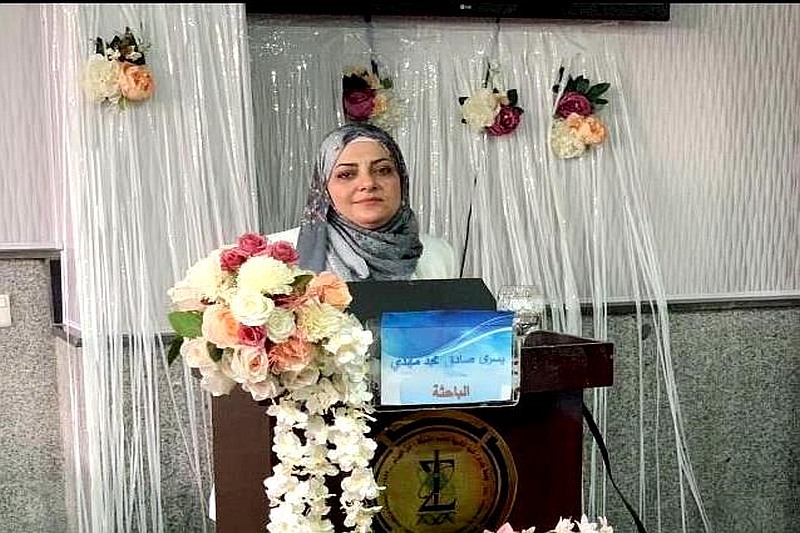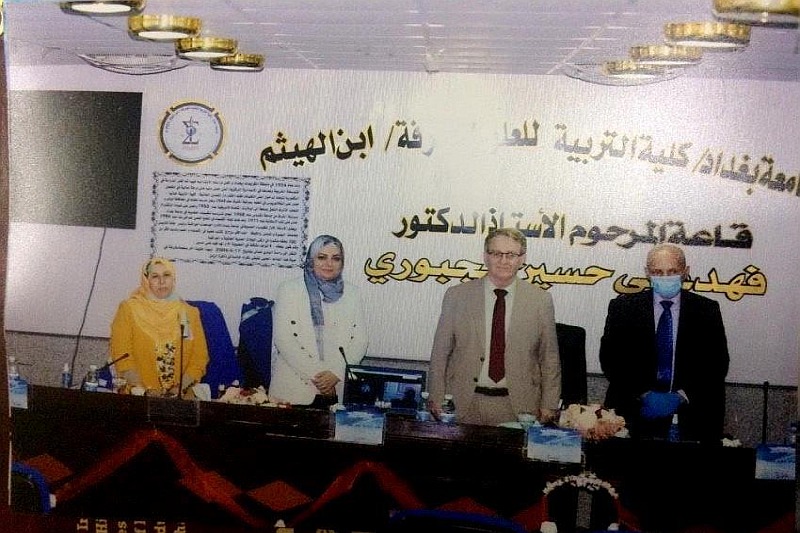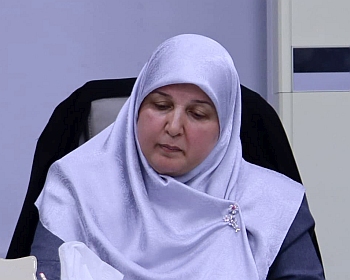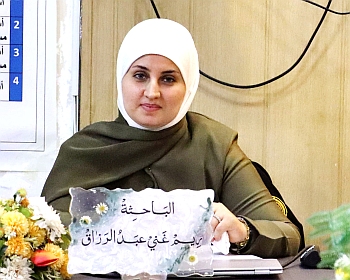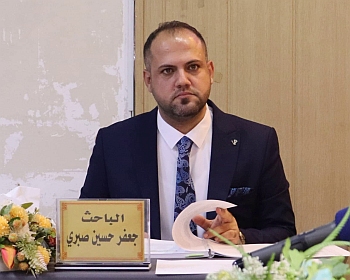ناقش قسم الكيمياء في كلية التربية للعلوم الصرفة (ابن الهيثم) رسالة الماجستير الموسومة ( تحضير متراكبات نانوية من اوكسيد الغرافين-اوكسيد الحديد-اوكسيد الزنك ودراسة الفعالية البايلوجية والتفكك الضوئي للاصباغ ) للطالبة ( يسرى صادق محمد مهدي ) التي انجزتها تحت اشراف التدريسية في القسم ( أ.م.د. انتصار عليوي لعيبي ) ونوقشت من قبل لجنة المناقشة التي تالف من الذوات المدرجة اسمائهم فيما ياتي:
-
أ.د. حميدة عيدان سلمان (رئيساً)
-
أ.د. عبد الكريم محمد علي جبر (عضواً)
-
أ. م. د. حسام سليم خلف (عضواً)
-
أ. م. د. انتصار عليوي لعيبي (عضوا و مشرفا)
وتهدف الرسالة الى :
-
استخدام طرائق جديدة لتحضير المتراكب (ZFGO) بوساطة ترسيب الجسيمات النانوية المغناطيسية (Fe3O4 MNPs) على صفائح أُكسيد الغرافين لينتج عنه المتراكب الثنائي النانوي (FGO)، والخلط المغناطيسي للجسيمات النانوية (ZnO NPs) مع المتراكب الثنائي (FGO) بالنسب الوزنية (1:2).
-
تطبيق المواد النانوية المحضرة في هذه الدراسة في دراسة التأثير التآزري للامتزاز والتحفيز الضوئي وايجاد النسبة المئوية لكفاءة التحفيز الضوئي.
-
تعيين الزمن اللازم لامتزاز صبغة (MB) اتزان (امتزاز/ ابتزاز) على سطح المتراكب (ZFGO) في الظلام.
-
دراسة تأثير بعض العوامل التي تؤثر في كفاءة التحفيز الضوئي مثل تغيير وزن السطح والتركيز الابتدائي للصبغة ودرجة الحرارة.
-
دراسة بعض الخواص الفيزيائية للمواد النانوية المحضرة قيد الدراسة والمتمثلة بدراسة الخواص الحرارية والخواص المغناطيسية وتعيين المساحة السطحية.
-
دراسة الفعالية المضادة للبكتريا لكل من (ZnO NPs, FGO, ZFGO).
-
استعمال المتراكب (ZFGO) كمحفز ضوئي يعمل على تسريع إزالة صبغة المثيلين الزرقاء من محاليلها المائية.
وبينت الطالبة في مستخلص رسالتها ان صفائح أُكسيد الغرافين عبارة عن مركبات لمادة مجهرية قابلة للثني صلبة ولكن مرنة كما تكون هذه الطبقات متشابكة على نحو مشدود نسبياً، يمكن تجميع ألواح أُكسيد الغرافين على شكل صفائح تُشبه الركائز (GO-based)، يمكن استعماله مع المعادن وأكاسيدها لتكوين متراكبات نانوية جديدة لتعزيز فعالية هذه المركبات في عمليات كالامتزاز والتحفيز الضوئي، تم في هذه الدراسة وصف طريقة لتحضير المتراكب الثلاثي (ZnO/Fe3O4/GO)، وذلك من خلال تحضير الصفائح النانوية أُكسيد الغرافين (Graphene Oxide) باعتماد طريقة همر(Hummers method)، كما تم تحضير الجسيمات النانوية أُكسيد الحديد المغناطيسي (Fe3O4 Magnetic nanoparticles) بوساطة طريقة الترسيب المشترك (Co-precipitation) لأيونات الحديدوز والحديديك في الوسط القاعدي وبوجود الصفائح النانوية لأُكسيد الغرافين كدعامة لحصول الترسيب المشترك لأيونات الحديد عليه، إذ تم الحصول على المتراكب النانوي الثنائي (Fe3O4/GO)، في الخطوة التالية تم اضافة الجسيمات النانوية أُكسيد الزنك (ZnO nanoparticles) المحضر مسبقاً الى المتراكب الثنائي (FGO) وبالنسب الوزنية (1:2) للحصول على المتراكب الثلاثي (ZFGO).
لتشخيص المواد النانوية المحضرة تم اعتماد عدة تقنيات هي:
-
مطيافية الأشعة تحت الحمراء تحويل فورييه
Fourier-Transform Infrared Spectroscopy (FTIR) .
-
حيود الأشعة السينية X-Ray Diffraction (XRD).
-
المجهر الالكتروني الماسح ذي انبعاث المجال مع الجهاز الملحق
Field Emission Scanning Electron Microscopy (FESEM) & Energy Dispersive X-ray Detection (EDX).
-
تحليل مجهر القوى الذرية Atomic Force Microscopy (AFM).
-
المجهر الالكتروني النافذ Transmission Electron Microscopy (TEM).
كما تم قياس بعض الخواص الفيزيائية كالخواص الحرارية باستعمال التحليل الحراري المتزامن (Thermogravimetry Analysis (TA)) الذي يتضمن كل من تحليل وزني حراري (Thermogravimetric Analysis (TGA)) ومسعر المسح التفاضلي (Differential Scanning Colarimeter (DSC))، إذ بينت نتائج التحليل الوزني الحراري لأُكسيد الغرافين فقدان في الوزن عند (600°C) يصل ~ (53%) اما المتراكب الثنائي النانوي (FGO) يفقد ~ (16.8%) من وزنه عند (800°C)، اما الجسيمات النانوية (ZnO NPs) التي تمتلك ثباتاً حرارياً جيداً يبلغ إجمالي تغير الوزن ~ (3%) عند درجة حرارة (800°C)، اما المتراكب الثلاثي (ZFGO) يفقد ~ (8%) من وزنه عند درجة حرارة (800°C)، وقياس الخواص المغناطيسية باعتماد طريقة الاهتزاز المغناطيسي للنموذج (Vibrating Sample Magnetometer (VSM)) وكان الاشباع المغناطيسي (magnetization saturation) لكل من (Fe3O4 MNPs, FGO, ZFGO) هو (10, 35, 45 eum/g) على التوالي، كما تم تقدير المساحة السطحية وحساب معدل قطر المسام للمواد المحضرة باعتماد طريقة (Brunauer-Emmett-Teller (BET)) وطريقة (Barreet-Juyner-Halenda (BJH)). كذلك تم قياس الفعالية المضادة للبكتريا لكل من (ZnO NPs, FGO, ZFGO) باستعمال انواع من البكتريا هي (Escherichia Coli, Staphylococcus aureus, Pseudomonas aeruginosa, Bacillus) باعتماد طريقة منطقة التثبيط (inhibition zone) بعد مرور (24 h).
تم تعيين الزمن اللازم لامتزاز صبغة (Methylene Blue) اتزان (امتزاز/ ابتزاز) على سطح المتراكب الثلاثي (ZFGO) حيث اجريت تجارب الامتزاز في الظلام وأظهرت النتائج أن أفضل مدة لحدوث الاتزان هي (60 min) عند درجة الحرارة (298 K).
كما تم اختبار كفاءة التحفيز الضوئي للمواد النانوية المحضرة من خلال متابعة التغيير في امتصاصية صبغة المثيلين الزرقاء MB باعتماد مطيافية الأشعة فوق البنفسجية-المرئية، وكانت النسبة المئوية لتحلل صبغة MB خلال (180 min) لكل من (ZnO NPs, FGO, ZFGO) تساوي (95%, 64%, 85%) على التوالي، كما تم دراسة بعض العوامل التي تؤثر في كفاءة التحفيز الضوئي للمتراكب (ZFGO) مثل تأثير وزن المحفز الضوئي، تأثير التركيز الابتدائي للصبغة وتأثير درجة الحرارة. وفقاً للنتائج كان أفضل وزن للمتراكب (ZFGO) هو (0.5 g) إذ كانت النسبة المئوية لتفكك صبغة MB ~ (75%) بعد مرور (120 min) تحت الاشعاع الشمسي.
وخلصت الطالبة الى جملة من التوصيات وهي :
-
استعمال المتراكب (ZFGO) في دراسة التأثير التآزري لعمليتي الامتزاز والتحفيز الضوئي لأنواع أخرى من الصبغات والأيونات.
-
دراسة حركيات التحفيز الضوئي لكل من (ZFGO, ZnO, FGO) والمقارنة بينها.
-
اعتماد طرائق كيميائية خضراء لتحضير المواد النانوية (ZFGO, ZnO, FGO).
-
استعمال المتراكبان (ZFGO, FGO) في عملية تنقية المياه من الملوثات باعتماد تقنيات أخرى مثل: Fenton.
-
تطبيق نماذج فريندلش ولانكماير وتمكن على المتراكبان (ZFGO, FGO) عند درجات حرارة مختلفة.
-
دراسة خواص فيزيائية أخرى للمواد قيد الدراسة، مثل: مثل الخواص الضوئية والخواص الكهربائية.
-
دراسة تأثير الاملاح في كفاءة التحفيز الضوئي للمواد النانوية المحضرة في الدراسة.
-
دراسة الفعالية المضادة للبكتريا لكل من (ZFGO, ZnO, FGO) بشكل مفصل من خلال دراسة العوامل التي تؤثر في زيادة هذه الفعالية او نقصانها كالتركيز وتأثير التحفيز الضوئي في الفعالية واستعمال انواع اخرى من الكائنات الحية الدقيقة والفطريات.
-
استعمال محفزات ضوئية اخرى مع المتراكب (ZFGO) لزيادة كفاءة التحفيز الضوئي ودراستها مثل (TiO2).
-
استعمال مواد كاربونية اخرى بدل أُكسيد الغرافين مثل الغرافين أو انابيب الكاربون النانوية كركائز للمحفزات الضوئية والمقارنة بينها.
Preparation of Graphene oxide- Iron oxide- Zinc oxide nano-composites and study the Biological activity and Dyes photodegrdation
By Yosra Sadiq Mohammed
Supervised by Asst. Prof. Dr.Entisar E. Al-Abodi
Abstract
Graphene oxide sheets are compounds of a microscopic material that is bending solid but flexible and as these layer are relatively tightly intertwined, graphene oxide sheets can be assembled in the form of substrate-like plates (GO-based), it can be used with minerals and their oxides to form new nanocomposites to enhance the effectiveness of these compounds in processes such as adsorption and photocatalysis
In this study, a method for preparing a new ternary composite (ZnO/Fe3O4/GO) was described by preparing Graphene Oxide Nano sheets (GO) using the Hummers method, and the magnetic Iron Oxide nanoparticles (Fe3O4 MNPs) was prepared by the Co-precipitation method of ferrous and ferric ions in the base medium and with the presence of Graphene Oxide Nano sheets as a support for the joint sedimentation of Iron ions upon it. a binary nanocomposite (Fe3O4 /GO) was obtained, In the next step, the previously prepared Zinc Oxide nanoparticles (ZnO NPs) were added to the binary composite (FGO) and weights ratios (2:1) to obtain a ternary composite (ZFGO)
To characterization the prepared nanomaterials, several techniques have been adopted
Fourier-Transform Infrared Spectroscopy (FTIR)
X-Ray Diffraction (XRD)
Field Emitting Scanning Electron Microscopy (FESEM) & Energy Dispersive X-Ray Detection (EDX)
Atomic Force Microscopy (AFM)
Transmission Electron Microscopy (TEM)
Some physical properties were measured, such as thermal properties using (Thermogravimetry Analysis (TA)) which includes both (Thermogravimetric Analysis (TGA)) and (Differential Scanning Colarimeter (DSC)), as the result of the (TGA) of (GO) showed a weight loos at (600°C) reach to ~ (53%), while the nanocomposite binary (FGO) lost (16.8%) of its weight at (800°C), as for the nanoparticles (ZnO NPs) that have good thermal stability, the total weight change ~ (3%) at (800°C), while the ternary composite (ZFGO) loses ~ (8%) of its weight at (800°C), and measuring the magnetic properties by adopting the method Vibrating Sample Magnetometer (VSM) and the magnetization saturation of (Fe3O4 MNPs, FGO, ZFGO) was (10, 35, 45 eum/g), respectively, the surface area was determination and the pore diameter ratio of the prepared materials was calculated using the Brunauer-Emmett-Teller (BET) and Barreet-Juyner-Halenda (BJH) method
The anti-bacterial activity of (ZnO NPs, FGO, ZFGO) was also measured by using different types of bacteria (EscherichiaColi, Staphylococcusaureus, Pseudomonasaeruginosa, Bacillus) using the inhibition zone method after (24 h)
The time required to achieve an adsorption/desorption equilibrium between the photocatalyst and Methylene blue molecules was determined on the surface of the ternary composite (ZFGO) where adsorption experiments were conducted in the dark and the results showed that the best equilibrium time was (60 min) at a temperature (298 K)
The photocatalysis efficiency of the prepared nanomaterials was tested by following the change in the absorbency of MB dye by adopting UV-visible spectroscopy, and the percentage of degradation of the MB dye during (180 min) for each of (ZnO NPs, FGO, ZFGO) was equal to (95%, 64%, 85%) respectively, some factors affecting the efficiency of photocatalysis of the composite (ZFGO) were studied, such as the effect of the photocatalyst weight, the effect of the primary concentration of the dye and the effect of temperature. According to the results, the best weight of the composite (ZFGO) was (0.5 g), as the percentage of dissociation of the MB dye (75%) after passing (120 min) under the solar radiation
The possibility of using composite (ZFGO) for industrial wastewater treatment by the synergistic effect of adsorption and photocatalysis.
The results showed precipitation of nanoparticles (Fe3O4 NPs) on graphene oxide sheets, then precipitation of nanoparticles (ZnO NPs) on binary nanocomposite (FGO) to synthesis of the ternary composite (ZFGO).
The results of the analysis of theField Emitting Scanning Electron Microscopy (FESEM) & Energy Dispersive X-Ray Detection (EDX) showed that the prepared nanomaterials were in the nanoscale as they showed high purity of the prepared nanomaterials.
The results of the testing of the (AFM) showed that the prepared nanomaterials were in the nanoscale. It can also be observed that the precipitation of (Fe3O4 NPs) on graphene oxide sheets, and the precipitation of (ZnO NPs) on the surface of the (FGO) nanoparticle can also be observed.
The equilibrium time (adsorption/ desorption) between MB dye and composite (ZFGO) was (60 min).
The synergistic effect of adsorption and photocatalysis of the nanocomposite (ZFGO) to remove the MB dye, the study of the effect of changing the weight of the compound (ZFGO), the effect of the initial concentration of the dye and the effect of raising the temperature were shown, as the study showed that the best weight of the composite (ZFGO) was (0.5 g), the initial concentration of the dye was (10 ppm) and the best temperature was (313 K).
The results of a preliminary study to compare the photocatalytic efficiency of the prepared nanomaterials under study showed that the nanocomposite (ZFGO) shows its efficiency as a suitable photocatalyst for removing MB dye compared to other materials that were used
The results of the anti-bacterial activity showed that the (ZFGO) nanocomposite have good activity compared to other nanomaterials under study


